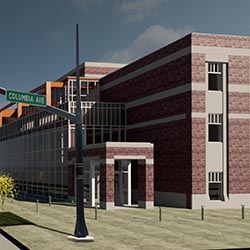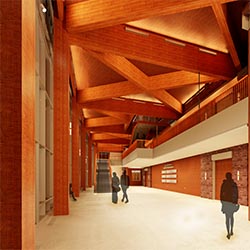
The Penn State team, comprised of now-recent graduates from the Department of Architectural Engineering, Andrew Stanton, Sierra Scott, Elena Gowdy, Alissa Anselmo, Kylie Scovern, Rebecca Brott, Tanner DeCrapio, Eric Iavarone, Austin Heidelbaugh, and Alex Gubler, were advised by Ryan Solnosky, assistant teaching professor of architectural engineering. IMAGE: PENN STATE
Architectural engineering students secure historic win
Green, collaborative performing arts center design earns first place at 2019 Architectural Engineering Institute Student Design Competition
6/18/2019
By Erin Cassidy Hendrick
UNIVERSITY PARK, Pa. — Achieving a historic win, Penn State undergraduate students earned first place in all five core categories at the 2019 Architectural Engineering Institute Student Design Competition, including the top honor for building integration.
Held this year at Penn State on April 5, the student design competition highlights the collaboration of multidisciplinary architectural engineering student teams, showcases the knowledge and application of design and construction principles to a real-world project scenario, and prepares students for a successful career in their chosen industry.
The Penn State team, comprised of now-recent graduates from the Department of Architectural Engineering (AE), Andrew Stanton, Sierra Scott, Elena Gowdy, Alissa Anselmo, Kylie Scovern, Rebecca Brott, Tanner DeCrapio, Eric Iavarone, Austin Heidelbaugh, and Alex Gubler, were advised by Ryan Solnosky, assistant teaching professor of architectural engineering.
In addition to the Building Integration award, the students also won top honors in Construction, Lighting/Electrical, Mechanical, and Structural Design. Other faculty members advising the Penn State team included M. Kevin Parfitt, professor of architectural engineering; Moses Ling, associate teaching professor of architectural engineering; Richard Mistrick, associate professor of architectural engineering; Craig Dubler, program manager in the Office of the Physical Plant; Shawn Good, practitioner instructor of architectural engineering; Marie Mayotte, operations engineer at the Office of the Physical Plant; and Michelle Vigeant, associate professor of acoustics and architectural engineering.
“We chose the name Syndicate for our team because we wanted to symbolize the collaboration,” Stanton said.
It was a fitting moniker for the group, as the comprehensive challenge pushed them to conceptualize and design a large-scale proposal for a high-performance musical arts center. Named the Jack H. Miller Center, the theoretical project was located in Hope College in Holland, Michigan, and was allocated an overall budget of more than $23 million.
“Our final project was an integrative and innovative musical performance center that was designed to optimize the occupant experience, as well as minimize the energy impact,” Gowdy explained.
“The biggest challenge was incorporating the acoustics into every facet of the design,” Stanton said. “It’s one thing to aesthetically design a musical performance space, but building the design correctly is another thing!”
Scott agreed, saying, “The team came together to research and develop methods to optimize the acoustical performance of the space.”
While their design was hypothetical, it was based on an actual building, and Syndicate’s work encompassed the vast knowledge and skills needed for an architectural project of this scale.
“To achieve this level of design, our team had to pull their comprehensive knowledge in their expertise areas as well as other discipline breadth knowledge to achieve a cohesive owner-focused design that promoted high-performance across goals,” Solnosky said. “This was done in conjunction with learning new material specific to performance hall design.”
Uniquely prepared for this project, the students commanded knowledge from a third-year experience in integrated building solutions, where a similar project is assigned. Weaving together five core classes in structural, acoustical, mechanical, lighting/electrical and construction engineering, the students were tasked with creating an all-encompassing building design across the course sections.
“At Penn State Architectural Engineering, the curriculum emphasizes system-of-systems thinking in every aspect of undergraduate education,” said Sez Atamturktur, the Harry and Arlene Schell Professor and department head of architectural engineering. “In these classes, the students evaluate the interdependencies between different building systems.”
Stanton credited those experiences in aiding their victory, adding that “the most impactful and innovative thing we did as a team was integrating our systems so well together.”
The final design showcased this dexterity and creativeness within their design and earned them first-place honors in: Building Integration, Construction Management and Development, Electrical Systems Design, Mechanical Systems Design, and Structural Systems Design, a first for Penn State.
“This project helped me become a better architectural engineer by making me push the boundaries of building design,” Gowdy said. “The project is a chance to coordinate with all disciplines needed to create a building and research new and upcoming technologies that could benefit the project.”
Their design also infused sustainability measures into every aspect of the building. As one of the competition parameters, the teams were challenged to incorporate 25 percent reclaimed wood in their project.
“We not only used it within our structural system, but we also made a point to expose the wood beams in the meeting rooms,” Stanton said. “It gave the space a warm, aesthetic feel while also being sustainable.”
Scott added, “Every discipline came together throughout the building to contribute to a green design.”
The project truly represented a culminating experience for the students, showcasing the Department of Architectural Engineering’s commitment to educating world-class engineers with a strong grasp of industry needs.
“With this competition and my education, companies have been so impressed, saying ‘This is exactly what we do in industry!’” Stanton said. “They kept saying, ‘I wish I had this experience during college.’ It definitely put me a step ahead in my career.”
Historically, Penn State AE has reached the finals in every year it has entered the competition.
“Since that initial event, 14 teams from AE have won a total of 50 awards,” Parfitt said. “This year’s win was another example of the long-standing tradition of dedication, hard work, technical competence, and imagination that is the hallmark of the Penn State architectural engineering program.”





